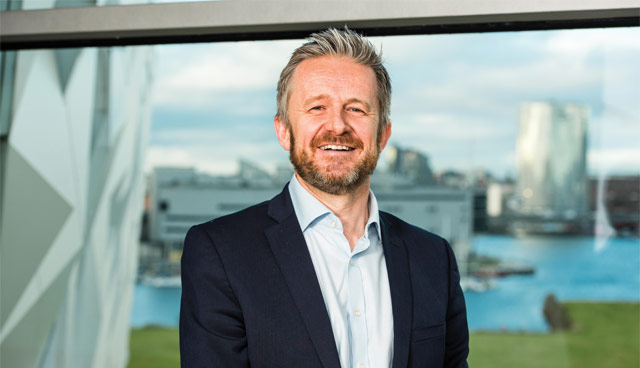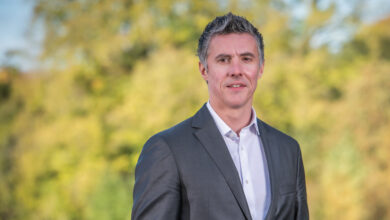A different environment

The Department for Infrastructure’s Chief Planner and Director of Regional Planning, Angus Kerr, outlines the challenges and opportunities in an era of uncertainty, including the expansion of environmental compliance from central government to local government and beyond.
Highlighting a number of challenges currently facing the Department, ranging from adaptation for an outcomes-based approach set out by the draft Programme for Government; continuous improvement measures and oversight of environmental governance, as well as more common challenges across Northern Ireland such as political uncertainty, Brexit and climate change, Kerr believes it is important that the Department works to address some of the uncertainties, whilst taking a positive view to what opportunities may exist.
He addresses how the switch to an outcomes-based approach has coincided with recognition that whilst planning plays a pivotal role in creating better outcomes for citizens, it cannot be done in isolation. Instead, Kerr says that collaborative and imaginative working across government departments, local government and with other stakeholders can maximise the ability to achieve aspirations.
This collaboration is a key tenet of work in developing a regional infrastructure plan for Northern Ireland. Currently the Department is developing research to inform a plan that will look forward to 2040/50, taking account of “demographic, environmental, economic and technological changes” that will impact on the region. “It is an interesting piece of work to be involved in and, in many ways, it will bring a new approach to long-term infrastructure planning for the region,” says Kerr. Adding that the Department aims to have preparatory work on the plan completed for the arrival of an incoming minister.
Collaboration is also a key theme of the local development plans currently being prepared by local planning authorities, which as Kerr describes, will allow councils, for the first time, to indicate where development should take place, facilitating greater and more meaningful community participation in planning. “The plan-led system increases certainty and should mean that decisions on individual applications are easier to make. We’ve got some way to go on that but when it is in place it will make a difference,” he explains.
“The local development plan system aims to move away from the narrower land-use focus that we had in the past to a more place-shaping approach, providing a unique opportunity for councils to incorporate linkages to other functions such as local economic development, regeneration, tourism and also, within the framework of the overall local community plan.”
Currently 10 of the 11 local authorities have published their preferred options papers on their local development plans, with two councils publishing draft plan strategies.
In addition to this, the Department is currently developing local transport plans in conjunction with councils, something Kerr sees as a “golden opportunity” alongside the development plan to create places which contribute to wider sustainability and health outcomes.
Oversight and governance
As part of the new two-tier planning system, the Department is responsible for oversight and governance of the system. One area in particular where it has faced challenges is around the escalation of environmental correspondence, engagement and legal challenges. Kerr outlines that the Department is working with local government to support improved environmental governance and compliance across the planning system as a whole. In particular, the Department has been providing guidance on the requirements of the Planning (Environmental Impact Assessment) Regulations (Northern Ireland) 2017. As well as a training programme being devised for both departmental staff and councils, Kerr confirms that the Department is also providing further information and advice on key cases and judgements, as they come forward, for the wider planning community and developing a forum for the sharing of best practice.
“A key element of this work will be focussing on effective enforcement action, particularly for retrospective applications and situations, and also in relation to EIA development.”
Continuous improvement
Turning to performance management and continuous improvement, Kerr admits that the indicators for the processing of major applications are not being met but highlights annual improvements in processing times. He believes that the process is moving in the right direction, and that work between the Department and councils to improve performance must continue. However, he also highlights his belief that much of the work being carried out by planning authorities is not being recognised in the three basic performance indicators.
“We have a unique opportunity now to make a positive change for the period ahead but we need collaboration, communication and close working to ensure that we foster existing relationships and explore new ways of working.”
For this reason, the Department is currently working to develop a broader range of planning indicators and monitoring mechanisms to take account of wider issues around performance of the system, quality of decisions and outcomes. “This will help us and the councils to identify best practice and to drive forward with continuous improvement,” he states. “We’re now very close to finalising that framework with local government and we are hoping that it will be issued this financial year.”
Common challenges
Climate change, technological advances, an ageing population and concerns around energy sustainability are just some of the challenges Kerr alludes to when discussing the wider government agenda of addressing the current and future needs of the population. Planning, he states, is not a panacea, but can clearly influence overall wellbeing. Pointing to how well-designed places and infrastructure can have wider benefits for society, he asserts that a great opportunity exists to integrate community engagement with the goal of contributing to wider sustainability.
This engagement is crucial to the overall ambition of making planning more people-centered and is a key facet of Living Places, an urban stewardship and design guide aimed at clearly establishing key principles behind good place-making. The guide is a departure from previous guidance, moving away from a land use focus to a place-shaping approach.
“It’s a collaborative vision which acknowledges that successful places are not just a result of buildings but by the overall way that buildings and the spaces around them are used,” explains Kerr. It provides fresh leadership to all those who are involved in place-making, by emphasising the value of different parties working together in order to maximise the full potential of a place. We want to move towards shaping places with, rather than for, those who use the spaces.”
Brexit
Probably the most predominant cross-governmental challenge is that of Brexit and its related uncertainty. Kerr highlights that the Department continues in its preparatory work to ensure the necessary legislative amendments are in place for exit day. For planning, this has meant engagement with the Ministry of Housing, Communities and Local Government to consider over-arching policy frameworks that will have to be put in place. “The challenge for us in planning is more around these longer-term issues, as opposed to day-one readiness,” he states.
On political uncertainty, he says that the recent introduction of The Executive Formation and Exercise of Functions Act and its associated guidance has meant that officials are now required to assess planning and other decisions against this Act, on a case by case basis, in the absence of ministers. “This work is our top priority at the moment and we are assessing all such decisions against the Act and guidance as quickly as possible,” he says.
Concluding, Kerr suggests that whilst the range of challenges to planning in Northern Ireland can appear daunting, collaboration can ensure the betterment of Northern Ireland as a place to live and work.
“I believe that we have a unique opportunity now to make a positive change for the period ahead but we need collaboration, communication and close working to ensure that we foster existing relationships and explore new ways of working.”





